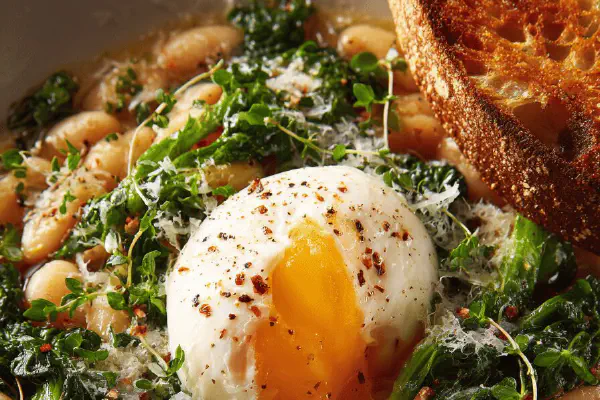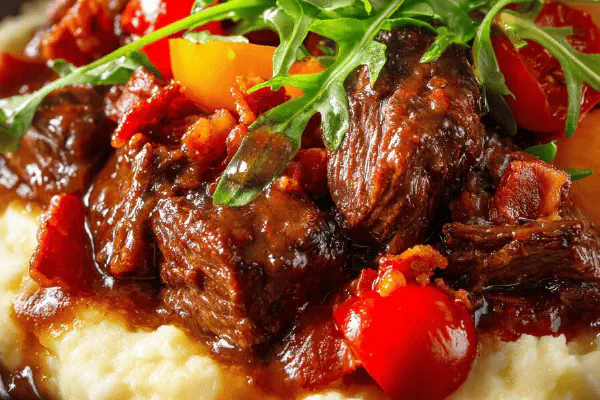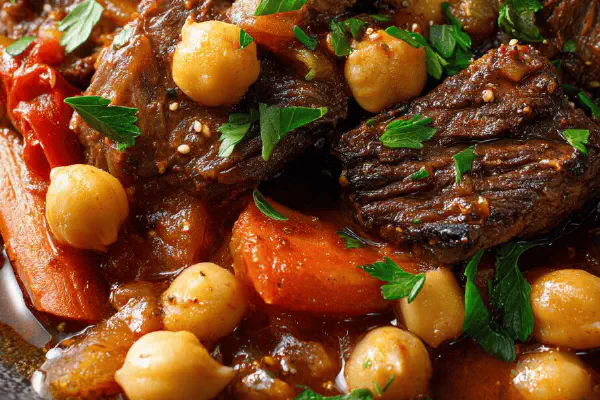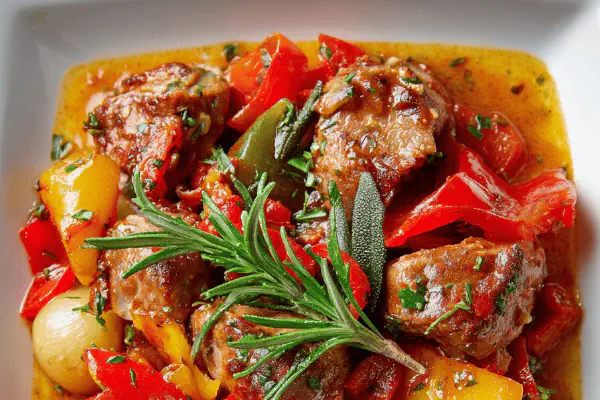Sausages with Flageolets
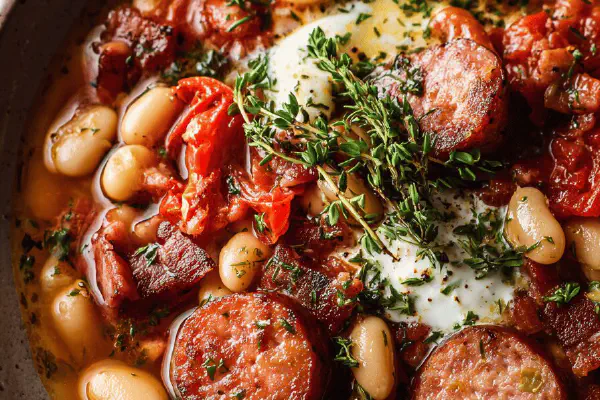
By Emma
Certified Culinary Professional
Ingredients
- 525 g dried flageolet beans (slightly more than 500 g)
- 2 medium onions, one whole and one chopped finely
- 3 cloves
- 1 carrot, peeled
- 3 fresh thyme sprigs
- 1 bay leaf
- 6 thick fresh sausages (Toulouse, garlic, or any pork-based link)
- 80 g pancetta, cut into small lardons (substitute smoked bacon if unavailable)
- 20 ml unsalted butter
- 5 garlic cloves, minced
- 10 ripe plum tomatoes, seeded and diced (can use canned whole peeled, drained)
- 400 ml rich chicken stock
- 150 ml heavy cream
- 65 ml flat-leaf parsley, chopped
- Salt and freshly ground black pepper
About the ingredients
Method
- Start by placing the flageolets in a big bowl and cover with cool water. Leave to soak at room temperature for minimum 4 hours, ideally 5. Top up water as they swell, beans soften but should not break apart. Soaking jumpstarts the cooking phase, reducing simmer time. Some skip this and the beans stay stubborn. Don't.
- Drain the beans well. Prepare a large heavy-bottom pot. Toss in drained beans with whole onion studded with cloves – stab them firmly so the cloves hold – plus peeled carrot, 2 thyme sprigs, and bay leaf. Season lightly with salt; keep it moderate here to avoid toughening skins.
- Add cold water to cover the beans by about 3 cm. Bring to a rolling boil over high heat. As soon as it roars, lower to gentle simmer. Watch for the foamy scum rising. Skim that off promptly. Impurities; can taste bitter if left.
- Cook uncovered for about 1 hour 25 minutes, but listen and watch. Beans should give easily to gentle squeeze without falling apart. Near end, nestle in raw sausages right onto the pot surface; they'll poach slowly without breaking up. The fat will render into the beans.
- Lift off heat. Drain beans and sausages through colander. Bin the bay, carrot, onion, and thyme stems. Keep the beans and sausages warm. The aromatics have done their job.
- In a clean large saute pan, melt butter over medium flame. Add pancetta lardons; cook until the fat renders and edges crisp, about 3 minutes. The smell turns nutty and smoky—a sign it's right. If you have bacon instead, treat it the same.
- Toss in the finely chopped onion and garlic. Sizzle gently for 2 minutes till translucent, not browned. This step is crucial: garlic lacks bite, onion softens but keeps slight crunch.
- Pour in diced tomatoes. Stir. Let juices bubble, tomatoes break down slowly, roughly 5 minutes. The sauce thickens, deep red color emerges. This slows acidity and extracts sweetness.
- Add flageolets plus their cooking liquid to this pan. Pour in chicken stock and cream. Scatter remaining thyme sprig in for subtle aroma. Turn heat up till near simmer, stir to combine well.
- Let the whole thing bubble very gently for about 1 hour, uncovered, until sauce reduces and thickens, flavors concentrate. Periodically taste for seasoning—salt, pepper. The sauce should coat back of spoon thinly, not watery.
- Slice sausages into half inch (1.2 cm) thick rounds. Fold into the stew along with chopped parsley. Cook another 15 minutes at low heat to marry flavors but keep sausages tender, not dry.
- Taste once more. Adjust salt and pepper. The cream softens acid, pancetta brings smokiness, tomato freshness balances hearty beans and sausage richness.
- Cool to room temp before freezing in sealed containers. Handy for quick meals. Reheat slowly to avoid casing splitting.
- If pressed for time, soak beans overnight and reduce simmering by 15 minutes. For shortcut, canned white beans or cannellini substitute flageolets but flavor shifts, less authentic. Sausages can be bratwurst or merguez if you want a spicier spin.
- Always listen while cooking beans. Feel their bite, not mush. Smell must be earthy but clean. Remove aromatics before final sauce to avoid bitterness from overcooked herbs.
- Quick tip: pierce sausages once before cutting to prevent curling.
Cooking tips
Chef's notes
- 💡 Start soaking flageolet beans early or even overnight. Water level matters. Too high dilutes flavor; too low risks skins toughening. Skim scum layer frequently while simmering. It keeps flavor from turning bitter. Timing not hard and fast; feel beans for softness not mush. Near end, add sausages directly into pot surface so fat renders but casing stays intact—no boiling splatter or rupture.
- 💡 Pancetta is fat and flavor anchor here. Use smoked bacon if pancetta unavailable. Cut into tiny lardons. Cook slowly till edges crisp and fat melts gently. Don’t rush or brown garlic and onions after this—they need gentleness. Garlic softens and loses bite; onion stays faintly crunchy. Timing is subtle but makes sauce layers deep rather than flat.
- 💡 Tomatoes need to stew slow until they break down, roughly five minutes bubbling gently. Good ripe plum tomatoes work best. Use canned whole peeled, drained, if pressed but juice removal critical or sauce gets watery. Stir often or bottom may scorch. Color shifts to deep red; aroma turns sweet and rich, signals humor shift from sharp acid to mellowed fruit.
- 💡 Add beans plus their cooking liquid with chicken stock and cream—cream cuts acidity but can swap coconut cream if dairy intolerant, changes flavor profile markedly. Thyme sprig last minute for aroma but remove before serving to avoid bitterness. Simmer uncovered keeps sauce thick, reduces wateriness, concentrates notes. Stir occasionally. Taste frequently for salt and pepper control.
- 💡 Slice sausages evenly into roughly half-inch thick rounds. Fold in with chopped flat-leaf parsley last thing to keep fresh green burst. Cook low and slow 15 minutes. Sausages stay juicy, flavors merge but don’t dry out or break down casing. Cool stew fully before freezing. Hot causes sauce separation and laggy fat layers. Reheat gently, slow or casing pops and juices leak—ruins texture.
Common questions
Can I substitute flageolet beans?
Yes, other white beans like cannellini or navy work but flavor changes. Flageolets softer, mild nuttiness. Other beans firmer, may need adjusting soak and cook times. Soak is non-negotiable; short soak or none makes skins bitter and beans stubborn. Flavor suffers if skipped.
What if pancetta not available?
Smoked bacon or guanciale both fine. Bacon slightly smokier, guanciale fattier and richer. Adjust salt because bacon often saltier than pancetta. Render fat slowly; don’t crisp too fast or burn. Flavor foundation changes but cooking approach same—slow, gentle melting of fat and crisp edges.
How to know when sausages are cooked in stew?
Timing less than texture. They poach slowly in beans near end, test by pressing slice—should be tender, spring back slight. Internal heat important but don’t let boil hard or sausages burst casing. Curling reduced by piercing before slicing. Cooking after final fold-in keeps moist inside.
Best storage method for leftovers?
Cool completely in pot before transferring to sealed containers. Freeze in portion sizes. Sauce separates if frozen hot—fat layers harden in lumps, sauce turns oily when reheated. Defrost overnight in fridge, reheat gently on low heat to keep sausage and sauce cohesive. Avoid microwave blast reheats; uneven heat wreck texture.
